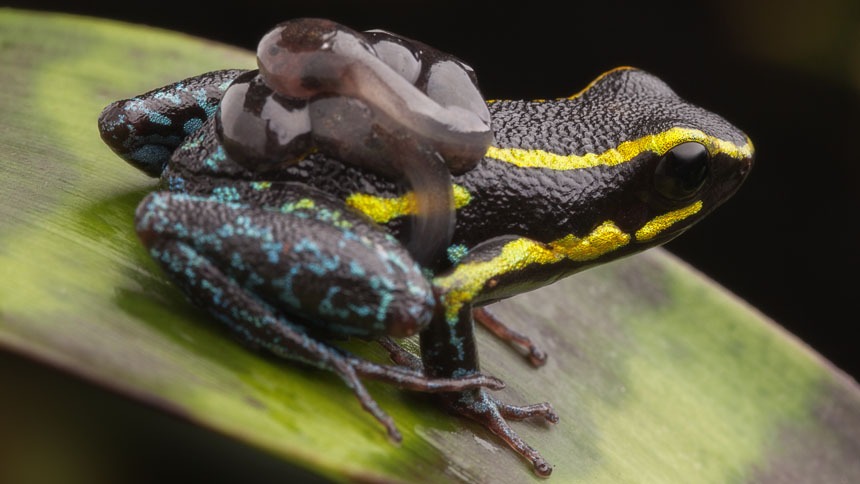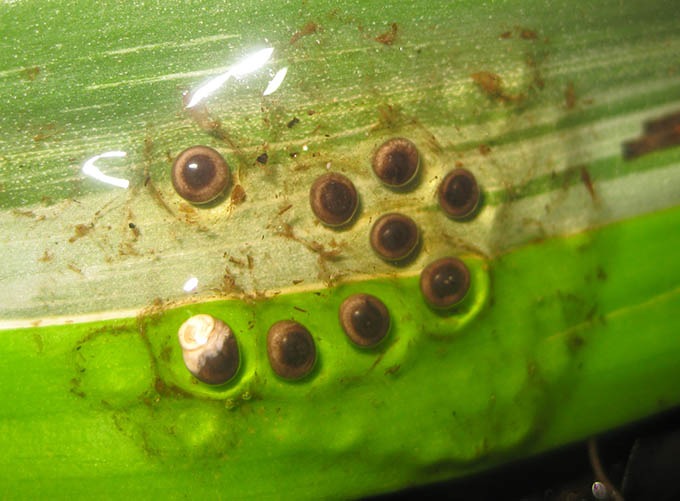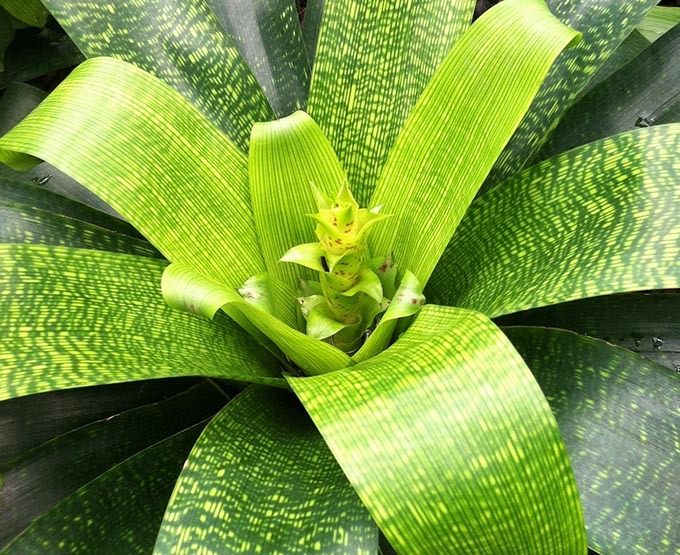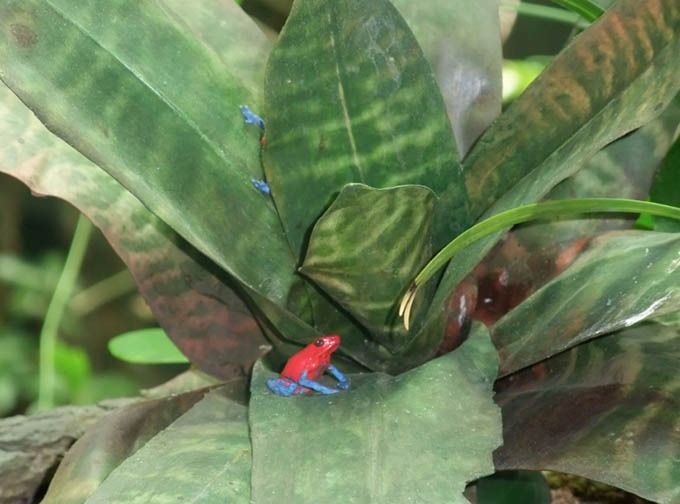
The Life Cycle of a Poison-Dart Frog
Frogs have an interesting life cycle due to metamorphosis. They begin their lives in a clutch of eggs, hatch into the water, transform into frogs and eventually hop on land as terrestrial creatures. The cycle repeats itself from there.
Most of us are familiar with the process, even without understanding it entirely. Dart frogs, however, have an interesting adventure in the midst of their already spectacular transformation from fully-aquatic swimmers to land-dwelling hoppers.
Their life begins in an egg, as do other tadpoles, but by the time they metamorphose into froglets, they’ve been carried like a backpack, spent some time in a flower, and trekked down a jungle canopy!
And that’s just a quick overview. The full story is very interesting. So, let’s get started.
Page Contents
The Beginning: Dart Frog Eggs
The life of a poison dart frog, commonly called “poison arrow frogs,” begins as an adult female lays her eggs on the ground. Frogs usually lay their eggs in water or attach them to the underside of a plant that is hanging over water; as the eggs hatch, the tadpoles fall into the water. That’s not the case here.

The female will lay her eggs in a burrow or sometimes under a leaf. The eggs are in a cluster and have a jelly-like sac surrounding them.
All of this happens, of course, after the female has found a proper mate. The process leading up to this is quite entertaining but I’ll cover this at the end of the page. Once the eggs are deposited, the male dart frog takes over…
Fertilization
Once the eggs are deposited, it’s up to the male to fertilize them. To be clear, this process takes place outside of the female’s body. In fact, she is most likely gone at this point.
After the eggs are fertilized, the male frog becomes the guardian and protector of his offspring.
This is quite different from most species. Typically, after a male amphibian fertilizes the eggs during amplexus, he takes off – never to be seen again. Not poison-dart frogs!
Tadpoles
Once hatched, the tadpoles wiggle their way onto their mother’s back. She then takes her tadpoles on a long journey to a safe location where they can begin metamorphosis. They will transform from tadpoles into froglets and eventually juveniles, capable of hopping on land.
The journey will have her carrying her tadpoles to the jungle canopy in search of a bromeliad.
A bromeliad is a tropical plant with lots of colors. What makes bromeliads special is that their leaves are able to hold tiny pools of rainwater.
That’s the very reason poison-dart frogs seek these colorful plants; the small pools of water serve as the perfect resting place for the tadpoles.

Once the mother locates a suitable bromeliad, the tadpoles are placed into their own pool of water between the plant’s leaves. Over the next 6 – 8 weeks, the little tadpoles will feed on mosquito larvae and algae. In addition to this, the mother
Did you know? This interesting bit of information is closely related to the life cycle of a poison dart frog; more specifically, the unfertilized eggs that the mother gives to the little tadpoles.
As you already know, poison-arrow frogs are indeed poisonous. They sequester an alkaloid‐based chemical from the food they eat in the wild. Without this toxic food source, they aren’t poisonous. This is why many people keep them as pets.
So, one might assume the tadpoles aren’t poisonous because they’re not big enough to consume the toxic arthropods that allow them to produce the poison. While it may be true that they’re not large enough to eat the arthropods yet, it’s not true that they aren’t poisonous.
You see, their mother is able to pass along the toxin through the unfertilized eggs she gives them as tadpoles. In short, this means that even the tadpoles of poison-dart frogs are poisonous! If you’re interested in learning more about this topic, check out the 2014 study from Ralph Saporito of John Carroll University. Otherwise, let’s get back the life cycle.
For more reading, check out the poison dart frog’s predators.
As time goes on, the little tadpoles metamorphose into young froglets. They grow legs and their tail disappears. Before long, they’re ready to make their journey back to the jungle floor.
Juvenile & Adult Poison Dart Frogs
After their journey back to the jungle floor, the juvenile dart frogs are ready to begin their life. It takes approximately one year, from start to finish, to go from eggs to full-grown adult frogs.
In total, the Dendrobatidae family (poison-dart frogs) contains 13 genera and roughly 170 different species! All of which have different colorations and levels of toxicity.
At this point, you could say the cycle is complete. All that’s left is for the new adult frogs to breed and start the cycle all over again. That is correct but it’s a bit more interesting than that. Dart frogs have some unusual mating rituals…

Mating Season
The rainy season is typically what sparks mating. The increased rain and warmer temperatures are responsible for the transition. (Captive dart-frogs may need to be cycled in order to get them to breed but that’s a topic for another page.)
During the breeding season, the males begin fighting with each other to establish territory. Some poison-dart frogs can be seen waving their arms at each other before engaging in a fight.
In some cases, the male frog loses the battle will submit by lowering its head or simply hopping away. The fights can be quite intense but once a winner is established, the next part of the process begins.
Last but not least, the victorious male dart-frog begins calling for a female companion by releasing a loud trill. When a male and female meet, they might wave at each other to show they’re interested. If the female is interested she waves back and this entire life cycle begins again
The female lays the eggs, the males fertilize and protect them, the female carries the tadpoles on her back to a tiny pool of water in a bromeliad plant, and the tadpoles eventually metamorphose into young froglets and make their journey back to the jungle floor.
Conclusion
As you can see, the life cycle of a poison dart frog is far different than that of other frogs. At least the beginning stages. Most eggs are placed in ponds, lakes, or streams and stay there during the entire process – not dart frogs. They get protection from their father and ride their mother’s back.
Sure, they survive off algae and mosquito larvae like other tadpoles but they do it from a tiny pool of water in a bromeliad plant. That’s unique! Anyway, I hope this information was helpful to you! Feel free to comment in the section below.

10 Comments
Very much helped me with my work about poison dart frogs! Thanks for the information!
Yep
Thanks I used this for a school project and this is the best site on poison dart frogs
This is good stuff, I used it for my science project
hey thanks i need this for my egg project
i like theme to
I love poison dart frogs. Thanks for the information!
Thank you so much for these very informative web pages.
I am currently looking at purchasing both Dart Frogs and Red Eyed Tree Frogs as I have numerous snake vivariums that I can use as terrariums to keep these fascinating creatures in.
Greatfully…. J
You’re welcome! Thanks for the nice comment!
thanks for the information